"Fashionable" hairstyles for women began their vertical climb in the late 1760s, and with them rose the ire of social critics. Editorials appearing in London periodicals immediately decried the large headdresses that English ladies were all too eager to copy from their French counterparts.
Chronicling the rise and fall of the fashion takes us from the courts of France to the printshops of London and finally to the streets of Philadelphia in 1778, where all that the high roll represented in a new nation at war with an old empire was brought quite literally to a head."1
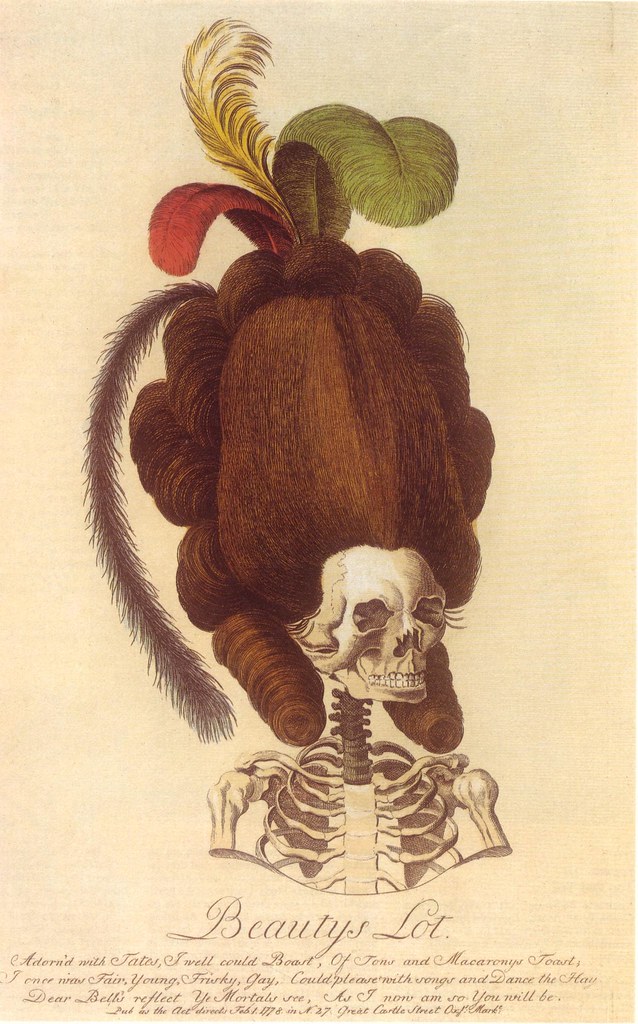
Beauty's Lot
Adorn'd with Tates, I well could Boast,
Of Tons and Macaronys Toast;
I once was Fair, Young Frisky, Gay
Could please with songs and Dance the Hay
Bells reflect Ye Mortals see,
As I now am so you will be
Published in London in 1778

The Green Stall
1777 etching published by Matthew Darly. The head of a young woman in profile is the foundation of a monstrous inverted pyramid of hair decorated with vegetables; carrots predominating. On the top are heaped a large bundle of asparagus, a set of scales in one bowl of which are potatoes, a bunch of herbs (taking the place of the ostrich feathers of fashion), a cabbage, turnips, &c. Large carrots take the place of the large curls then worn flanking the coiffure; three bunches of carrots are the main decoration of the surface of the hair, on which are also a cabbage and clusters of leaves (or lettuces). Trails of pea-pods hang from the top of the head-dress after the manner of the lace lappets and ribbons then worn.

Fruit Stall
Etching published by Matthew Darly in London in 1777. The head of a woman in profile is the foundation of a monstrous inverted pyramid of hair, decorated with the wares of a fruiterer. On the top are a basket of peaches and a large pineapple with its leaves. Down the side of the pyramid, where curls were worn, are large gourds of different shapes. The hair is further ornamented by two tall pottles of strawberries, bunches of grapes, pears growing on branches, a basket of plums, a basket of raspberries, and other fruit.

This is Something New
Published by J Lockington in 1777, this etching shows a lady with her hair in a gigantic pyramid, protected by an enormous umbrella on a very long stick. Her draped over-skirt projects at the back in mountainous folds (support known as the 'corks's rump'). On these is seated a foppishly dressed man taking shelter under the projection of her hair. A simple countryman, whose hat has fallen to the ground, gapes at the pair in amazement. A fashionably dressed man on the right leers and points at them.
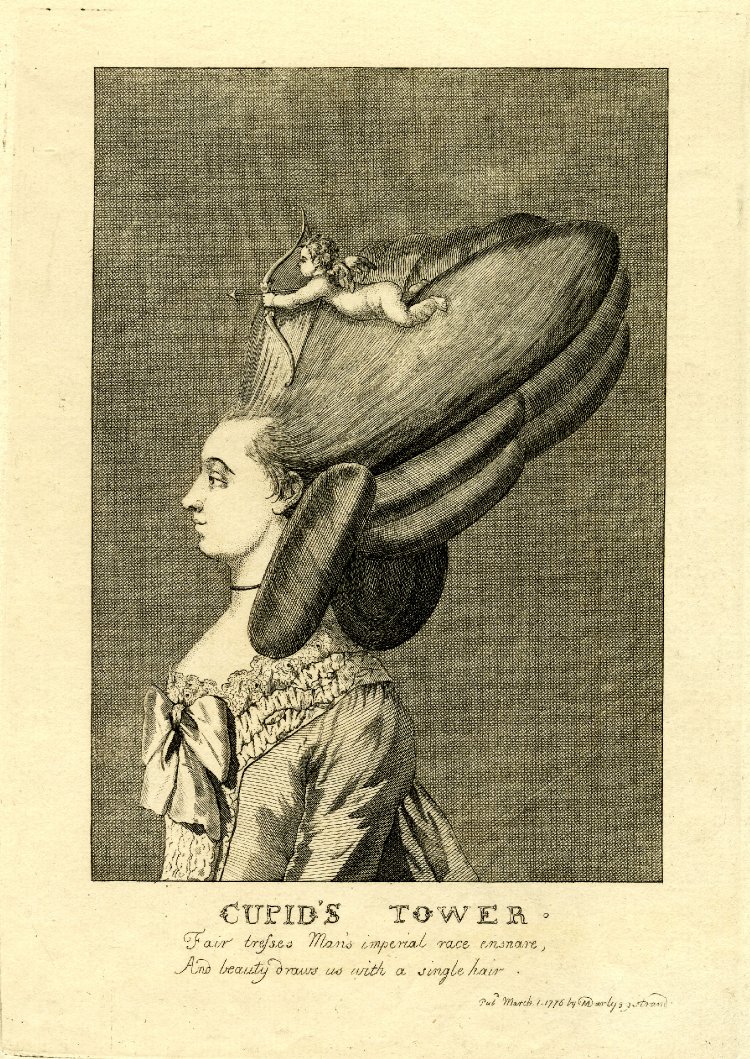
Cupid's Tower
Fair tresses Man's imperial race ensnare,
And beauty draws us with a single hair
A lady in profile with an enormous pyramid of hair in the fashion of the day. On the broad summit of the pyramid lies a miniature cupid fitting an arrow to his bow and about to aim in the direction in which the lady is looking. She wears the fashionable 'full-dress' of the period.

Mlle des Faveurs a la Promenade a Londres
Ma coiffure en effet ressemble au colombier,
Puisque tous ces pigeons viennent s'y reposer,
Mais en tirant dessus Anglois qu'allez vous faire,
Faut-il pour nos folies, vous rendre téméraires
Anonymous etching from about 1775. Satire on coiffures: A Frenchwoman with a ridiculously tall hair arrangement turns in amazement as an Englishman shoots at a flock of birds nesting in it.
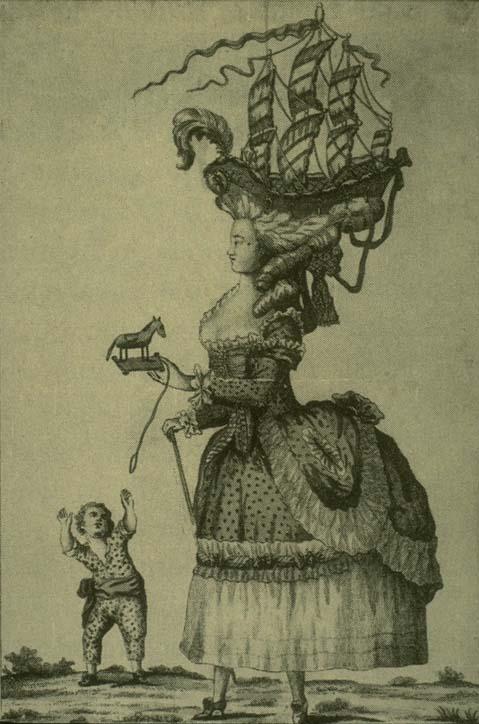
La coiffure à la Belle Poule
{Source. Also see a variation on this theme in colour: includes more images [Pt. 1]}
"The Belle Poule was a French frigate of the Dédaigneuse class, designed and built by Léon-Michel Guignace, famous for her duel with the English frigate HMS Arethusa on 17 June 1778, which began the French involvement in the American War of Independence."
"One of the most fashionable hairstyles of the eighteenth century, À la Belle Poule, commemorated the victory of a French ship over an English ship in 1778. À la Belle Poule featured an enormous pile of curled and powdered hair stretched over a frame affixed to the top of a woman's head. The hair was then decorated with an elegant model of the Belle Poule ship, including sails and flags."

Le Stratageme Amoureux, ou la Toilette à la Mode
(The Lovers' Strategy or Fashionable Grooming)
Anonymous 1770s etching (one of a series, all apparently by the same hand). Satire on coiffures: A Frenchwoman is kissed by her elderly husband, while a procession of cupids climb a ladder along her ridiculously tall hair arrangement to deliver letters to her young lover above.

Ridiculous Taste or the Ladies Absurdity

La Françoise à Londres. The French Lady in London,
or the Head Dress for the Year 1771
[Anonymous print after Samuel H Grimm]
"After Hogarth and before the French Revolution the humour directed at the French in caricatures is gentler. The satire is usually focussed on fashion and hairstyles, the latter being the subject of this print. The fashion for wealthy French women of the 1760s and 1770s was to wear their powdered hair tall, although this lady's coiffure is monstrously exaggerated."

The Female Pyramid
Anonymous 1771 etching from The Oxford Magazine, showing a hairdresser on a ladder with shears trimming the woman's absurdly high coiffure while a man views the action through a telescope.
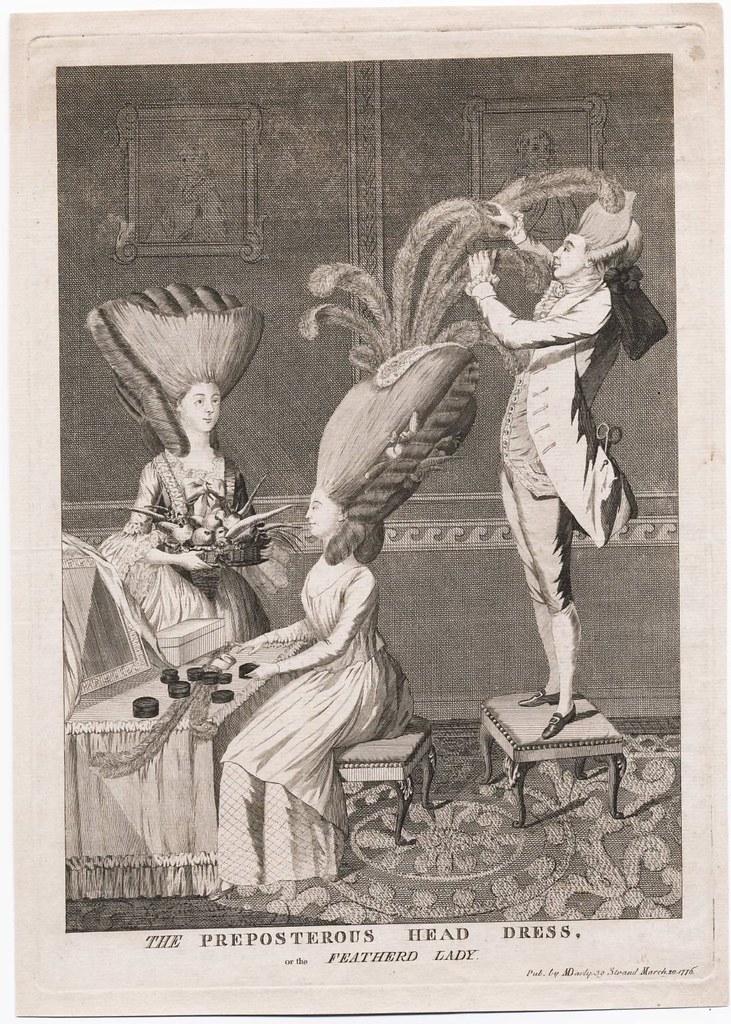
The Preposterous Head Dress, or, The Featherd Lady (sic)
Etched engraving, published by M Darly in 1776
"Both the lady and her maid sport the inverted heart-shaped pyramid all the rage in 1776 and 1777. The Duchess of Devonshire was said to have begun the fashion for ostrich feathers, seen here decorating the headdress along with fruit and carrots. Late in her life Lady Louisa Stuart wrote about the opposition to ostrich feathers as part of a headdress: 'This fashion was not attacked as fantastic or unbecoming or inconvenient or expensive, but as seriously wrong or immoral. The unfortunate feathers were insulted mobbed burned almost pelted.' "

La Brillante Toillete de la Déesse du Gout
{The Brilliant Grooming or the Goddess of Taste}
Qu'elle felicité pour ce jeune amoureux,
Il est dans ce moment au comble de ses voeux,
Puis qu'il peut sans rougir observer tour à tour,
Ces trésors enchanteurs, destinez à l'amour
1770s satirical print on coiffures: a Frenchwoman at her toilette wears one huge hair arrangement, while another is being prepared on her dressing table; two maids and a lover attend.
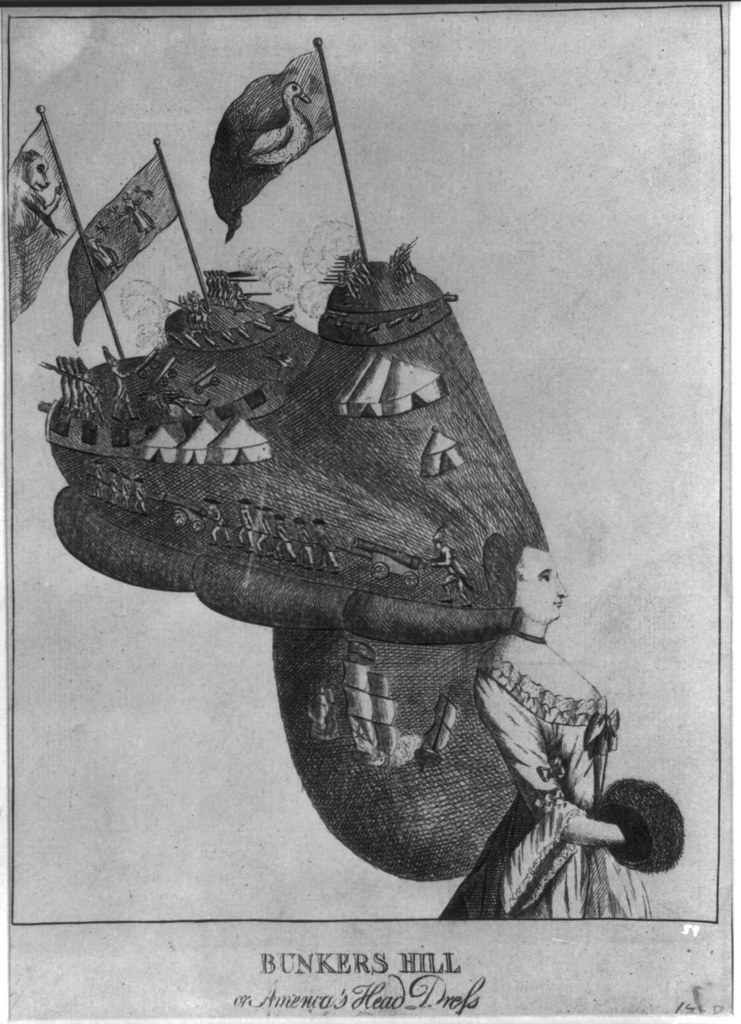
Bunkers Hill or America's Head Dress {1776}
"Prints such as Bunker's Hill, or America's Head Dress, show British troops trudging up the side of a high roll toward their stronghold opposite the American army's 'hill'. The image likened the colonial cause and military effort to the elaborate hairstyle: hollow, artificial, and short-lived."
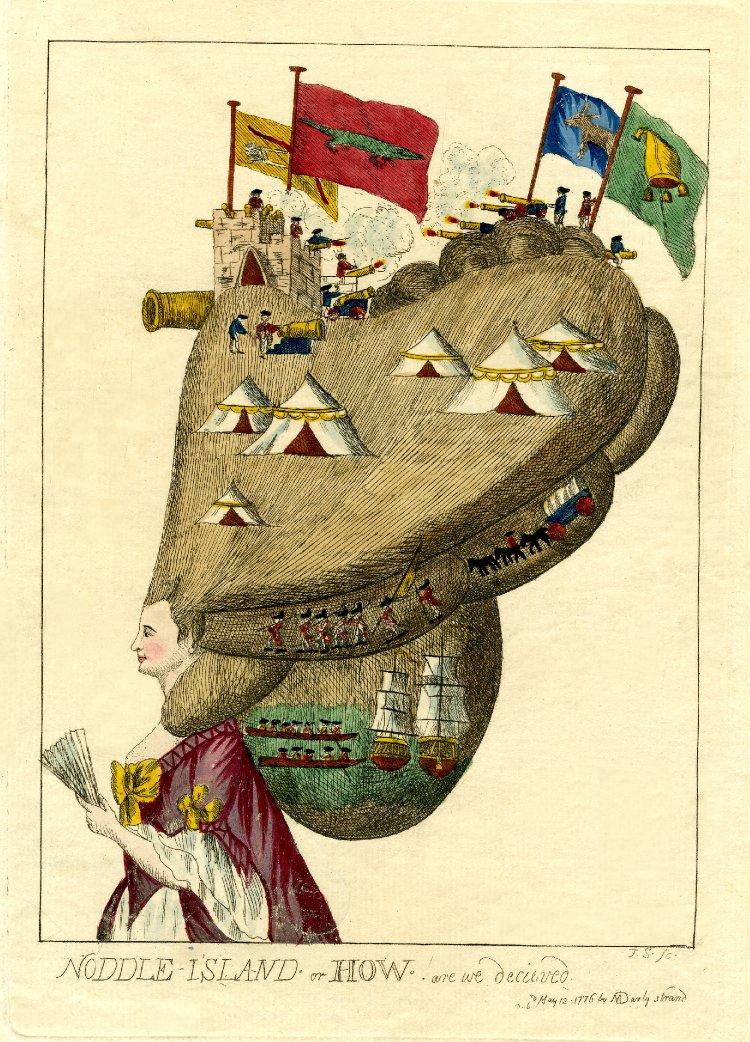
Noddle-Island or How are we Decieved
Hand-coloured etching published by Matthew Darly in 1776 depicting a lady on whose grotesquely extended coiffure military operations are proceeding. At the top of her pyramid of hair soldiers fire a cannon from a rectangular American fort at other soldiers firing a cannon from an adjacent mound composed of ringlets of hair. Two immense flags flying from the fort bear, one a crocodile, the other a cross-bow and arrows; the flags of their opponents, the English, are decorated one with an ass, the other with a fool's cap and bells. Below this combat are tents and two men with a cannon. On the lower right rolls of hair red-coats march in single file, followed by a baggage waggon. Lower down again, red-coats in boats are rowing towards two ships in full sail.
This evidently satirizes the evacuation of Boston by Howe on 17 Mar. 1776. There were many protests against the misleading account given in the 'Gazette'. Walpole wrote "nobody was deceived". The 'How' in the title is a pun on the name of the commander-in-chief.

The Extravaganza, or, The Mountain Head Dress of 1776
{Published by M Darly}
"..an almost hallucinatory invention ... at once barbarous and sophisticated ... The headdress takes on a potency of its own, a literal autonomy of fashion beneath which the wearer is reduced to impersonality." Diana Donald as quoted in this book [Amazon]

Rural Masquerade Dedicated to the Regatta'ites 1776
Published in London by J Lockington
"In the upper reaches of this headdress are figures dressed for a masquerade, promenading through a garden. Below is shown what may represent the first regatta in England, held 23 June 1775, partly on the Thames and partly at Ranelagh, where a temple of Neptune had been built. The bearer of this enormous coiffure, despite the female body, may be meant to be Neptune or Father Thames."

Lady All-Top
Published in London by J Lockington in 1776.
"Shown here is another magnificent heart-shaped pyramid of hair adorned with ostrich feathers, beads, and flowers, of the sort made fashionable by the Duchess of Devonshire in 1776. These hairstyles were labor-intensive and required cushions and wool, pomatum and powder, and an array of decorations. They were uncomfortable, they attracted insects and mice, and they could be fire hazards."
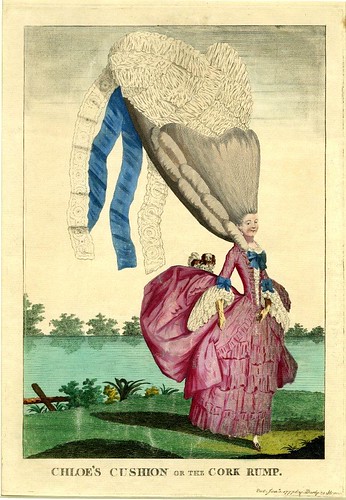
Chloe's Cushion, or, The Cork Rump
Print made by M Darly in 1777
A lady out walking by a lake, dressed in a grotesque caricature of the prevailing fashion. Her petticoats project behind her in an ascending curve, on which lies a King Charles spaniel. Her hair is dressed in a mountainous inverted pyramid, the apex represented by her head; it is flanked by side-curls and surmounted by interlaced ribbons from which hang streamers of ribbon and lace.

Oh Heigh Oh, or, A View of the Back Settlements
Published by M Darly in 1776. The print alludes to the region that is now Ohio which was then part of New France. Unlike the thirteen colonies on the eastern seaboard, New France was never effectively colonized and the population remained small. Since the main interest of the French was commercial exploitation (the basis of the economy was the fur trade), communities remained only frontier outposts.

Phaetona or Modern Female Taste
[jigsaw!]
Etched engraving published by M Darly in 1776.
"The lady and her hair dwarf the horses pulling her carriage, a phaeton. The Duchess of Devonshire may be the intended object of the satire here, given the ostrich feathers in the hair and the ducal coronet on the carriage."

The Ladies Contrivance or the Capital Conceit
Published by M Darly in 1777; artist: Miss Bath.
Juxtaposition of sedan chairs, one modified to accommodate the ridiculously exaggerated coiffure of its female occupant.
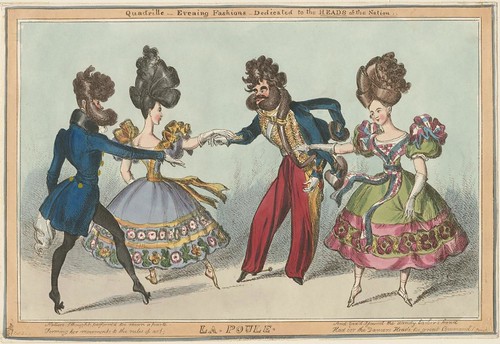
Quadrille - Evening Fashions - Dedicated to the Heads of the Nation. La Poule
[posted previously]
Nature I thought perform'd too mean a parte
Forming her movements to the rules of art;
And vex'd I found the dandy barber's hand
Had o'er the Dancers Heads too great Command
1827 print by William Heath and published by Thomas McLean. Dancing couples (including a man in Hassar uniform) with absurd hairstyles.
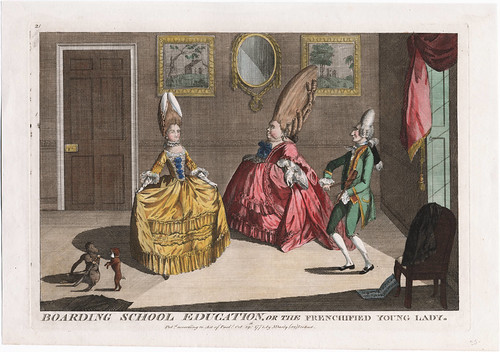
Boarding School Education, or the Frenchified Young Lady
Etching published by M Darly in 1771 with a young woman dancing to the violin played by her dancing master, while her proud mother sporting an enormous hairdo looks on. (note the poodle and monkey. The monkey, particularly, is a recurring satirical motif in many of these prints: preening? 'aping'? no smarter than apes?)

The Lady's Maid, or Toilet Head-Dress
Anonymous 1776 etching of a young woman with her hair in a much exaggerated inverted pyramid which fills the greater part of the design and is the support for a dressing-table, draped with muslin festoons. On it are an oval mirror, a pair of tapers in candlesticks, two vases of flowers, a pin-cushion, toilet articles, a pair of buckles, rings, a necklace, &c, two books, a pen.

Top and Tail

The Donry or Top and Tail Turn'd About
"Embellished with the French Favourite Circle called a la Zodiaque just imported. see Lady's Magazine N. XC. Humbly dedicated to the fine Ladies of the petty gentry by Monsieur Periwig from Paris." {Engravings by Miss Heel in 1777}

Long Corks or the Bottle Companions
Published by M Darly in 1777
Two extravagantly dressed women face each other, each seated on, or rather supported by, an enormous cork which projects from the neck of a bottle. Both are elderly, one (left) enormously fat, the other very thin. Both wear the grotesque pyramids of hair, flanked by ringlets like large sausages and surmounted by ostrich-feathers, so much caricatured since 1776. Their skirts are skimpy in front, showing the contour of their legs, but project in great panniers at the back. Both are gloved and hold fans. The cork and bottle of the fat woman is correspondingly broader than that of her thin vis-à-vis.

Proportion
Published in 1777 by J Lockington, this half-man half-woman print contrasts the gender styles of the time, exaggerating the female fashion and hairdo, while the male's appearance is more natural by comparison.

Miss Prattle, Consulting Doctor Double Fee about her Pantheon Head Dress
Hand-coloured mezzotint published by Carington Bowles in 1771. The counsellor and his client sit facing one another across a table, beneath which their knees touch. The lady wears a grotesquely high pyramid of hair, decorated with pearls or beads and a high lace cap with ribbons and lace lappets. She looks intently at the Counsellor who is wearing a legal tie-wig, gown, and bands. On the wall is a framed picture of two monkeys sitting on each side of a round table, each with a tea-cup.

Leaving off Powder, or A Frugal Family Saving the Guinea
Hand-coloured print by James Gillray, published by Hannah Humphrey in 1795: a satirical response to the tax on hair powder; including a portrait of Charles II with a huge powdered wig.
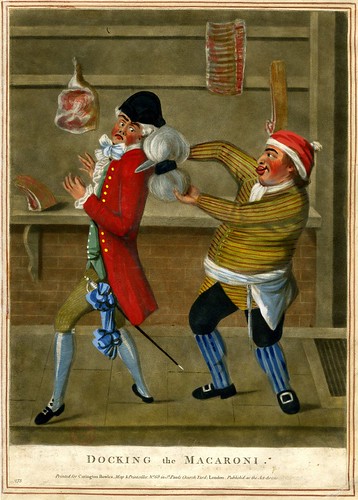
Docking the Macaroni
1773 hand-coloured mezzotint published by Carington Bowles of a butcher in front of his shop slicing off the ponytail of a passing Macaroni.

The Macaroni. A Real Character at the Late Masquerade
Mezzotint by Philip Dawe; printed for John Bowles in 1773
"This gentleman shows off the fashion of the day, from the rosettes on his shoes to the tiny three-cornered hat at the top of his headdress, a structure made of enormous side curls, a gigantic club, and a pyramid of hair. While the Oxford English Dictionary cites Walpole’s comment in 1764 as the first recorded use of the term, the Macaronies came to greatest prominence in the early 1770s."

Large Grotesque Head Being Strangled by its Own Hair
by Gaetano Piccini, 1727, in pen and brown ink.
(possibly a design intended for R Venuti's 'Antiqua Numismata')
Many of the above images have been spot/background-cleaned. The commentary is quoted or paraphrased from source sites (and elsewhere), as linked below.
The images were obtained from the following sites (in order of contribution numbers):
- The British Museum Collections Database.
- The Walpole Library Digital Collection at Yale University (via the exhibition site listed below).
- Vive la différence! The English and French stereotype in satirical prints, 1720-1815 at the Fitzwilliam Museum.
- The Library of Congress - Pictorial Americana.
- The Anne S. K. Brown Military Collection at Brown University.
- Thanks very much, yet again, to Will from AJRMS for sending a couple of scans my way which inspired this post {also see his bookplate contest and the 'best of'/overview post}
- Preposterous Headdresses and Feathered Ladies: Hair, Wigs, Barbers, and Hairdressers -- a Lewis Walpole Library exhibition.
- 1A Short History of the High Roll by Kate Haulman (2001) at Common-Place.
- Big Hair: A Wig History of Consumption in Eighteenth-Century France by Michael Kwass (2006) IN: The American Historical Review.
- Mary and Matthew Darly.
- 1750-1795 in fashion.
- UPDATE: I forgot about this catalogue [pdf] from Cora Ginsburg that has a page overview and a couple of images - among some other interesting things - from a contemporary book devoted to the art of the coiffure: 'L'Art de la Coeffure des Dames Françoises, avec des Estampes, ou sont Représentées les Têtes Coeffées' by Legros de Rumigny, 1768-1770.
- UPDATE 2: There are a few more "hair" pictures in the old post, Easy Pickings.

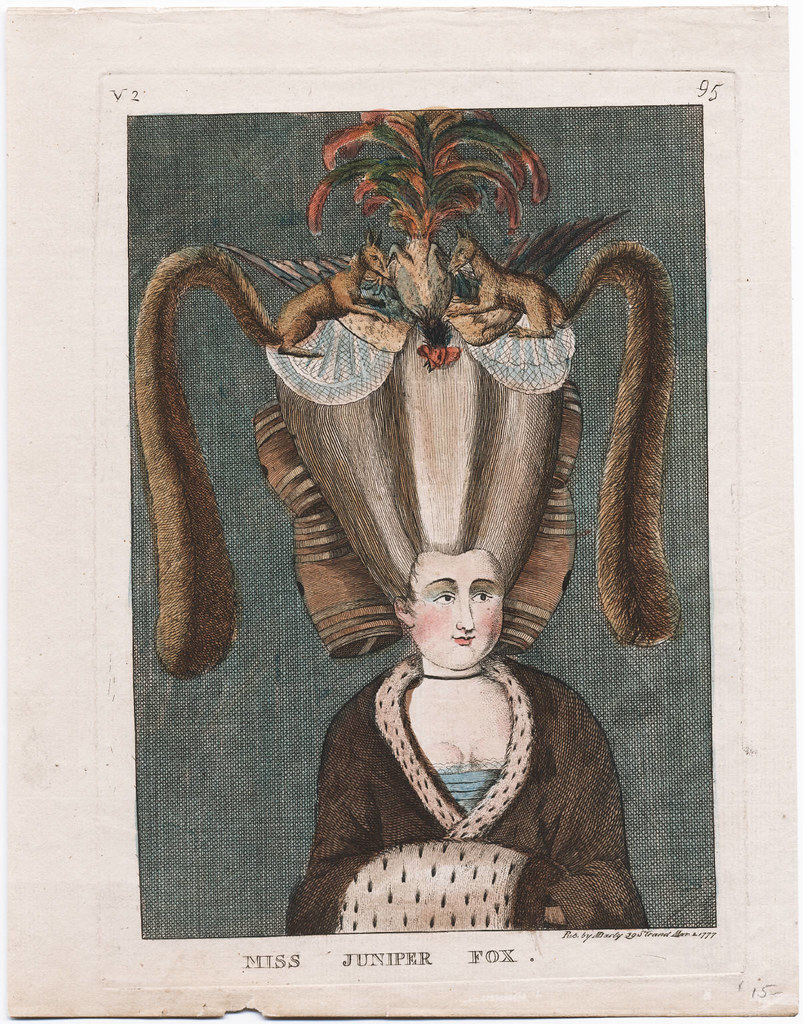



















22 comments :
while reading this most amazing post i sang to myself "she's got the whole world in her hair!"
very inspirational...makes me think of all kinds of comical scenarios...thanks for posting!
incredible images. brilliant post.
thank you
this is fabulous! a LOT of images i haven't seen.
sorry, but my english is not very good!
I have to ask you one question:
have you ever found illustrations with book's bonfire?... books in the fire...
i hope i write well!
thank you!
costanza.
Now that's what I call Big Hair!
Cheers. (Rachael, you put that song in my head: I heard it when I was waking up! I will find you. There will be repercussions!!)
Hey Costanza, write to me in your language via email: peacay -->gmail-->com
These are interesting yet absurd. Did the ladies suffer any back problems ?
I found your blog a month ago. I am hooked. Thank you for serving a serial dose of inspiration and humor to my day.
Amazing images and wonderful descripts. I must say the first one may be my favorite of all. How wonderfully compiled. GT
or on second thought my favorite may be the Title of the Post-just brilliant! G
I *just* worked out that Oh Heigh Oh was a pun on OHIO. *face --> palm*. Originally it reminded me of "♪hi ho, hi ho...it's off to work we go..♪", another aggravating earworm.
Brilliant images, must have taken you an Age to load them all! Thank you for sharing them with us all. Fabulous.
briliant post, thanks : ).
Fantastic! I've made a post with it on my own blog
Great post, I love all the illustrations. The hair is crazy and so big, love it
Now we know the inspiration for Elton John's famous birthday party hairdo, which necessitated his arrival in a delivery truck.. La coiffure à la Belle Poule!
I am at once appalled and envious! I have always been an advocate of big hair. These creations really give me something to strive towards.
These are all entirely magnificent, such a treasure to behold ones eyes upon. Some of them remind me of Georgiana the duchess of Devonshire.
So so inspiring, Thank you.
coool
Wow, you have to be impressed by this one for sure! I have been many times before by this French hairstyle sort of domination on the woman's behalf. You have to give them the credit were the credit's due. They really did things up right, those Ladies back in those times.
Phenomenal synopsis!
Post a Comment
Comments are all moderated so don't waste your time spamming: they will never show up.
If you include ANY links that aren't pertinent to the blog post or discussion they will be deleted and a rash will break out in your underwear.
Also: please play the ball and not the person.
Note: only a member of this blog may post a comment.